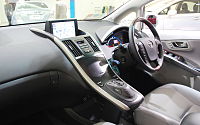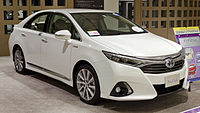Toyota Sai
| Toyota Sai | |
|---|---|
Lexus ES 300h (AXZH10) |
The Toyota Sai is a
The Sai was released in December 2009 as Toyota's second hybrid-only line after the Prius as Toyota brand model. Positioned between the Prius and the Crown Hybrid, the Sai came in a semi-fastback 4-door sedan body with a trunk. It was a sister car of the Lexus HS 250h that was released earlier in July, and the two models shared the basic components although they were differentiated by their interior and exterior designs. The Sai's body length, width, and height were smaller than those of the Lexus HS 250h by 95 mm, 15 mm, and 10 mm, respectively.
The highly aerodynamic body design extended even to the flat and smooth underfloor covers, attaining a drag coefficient of 0.27 which was among the best in its class. Although the Sai employed the Toyota Hybrid System (THS) II with a reduction gear mechanism (the same as that of the Prius), its engine was a more powerful 2.4-liter unit (2AZ-FXE) producing 150 PS, to which a 143 PS motor was combined to drive the front wheels. The fuel consumption was 23.0 km/L under the 10-15 test cycle.
The name comes from the Japanese word "sai" -which means "talent" and "coloration" when written with the Kanji character.[5]
On June 25, 2010, Lexus (Toyota) recalled 17,801 2010 model year HS250h and Sai models for failing to comply with US FMVSS 301, "Fuel System Integrity", due to the risk of excessive fuel leakage in the event of a rear-end collision. A recall for reprogramming the brake software was issued in February 2010.
On November 15, 2017, the Sai was discontinued and replaced by the
Gallery
- Pre-facelift
-
Front view
-
Rear view
-
Interior
- 2013 facelift
-
Front view
-
Rear view
-
Interior
References
- ^ a b "Affiliates (Toyota wholly-owned subsidiaries)-Toyota Motor Kyushu, Inc". Toyota Motor Corporation. 2012. Retrieved February 14, 2014.
- ^ Greimel, Hans (September 30, 2009). "Toyota is adding another hybrid sedan--the Sai--for the Japanese market". Autoweek. Retrieved February 7, 2014.
- ^ Hardigree, Matt (January 11, 2009). "Lexus HS 250h: A Prius For The Country Club". Jalopnik. Retrieved June 22, 2012.
- ^ "Toyota Receives About 14,000 Orders for the Sai in One Month". Green Car Congress. November 24, 2009. Retrieved February 7, 2014.
- ^ "75 Years of Toyota | Vehicle Lineage | In-depth Vehicle Information, Specification | Sai". Toyota. 2012. Retrieved June 4, 2022.
External links
- Official website (in Japanese)






